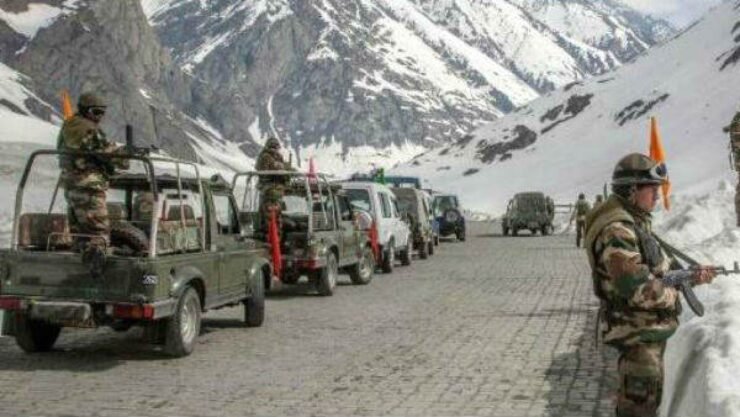
New Delhi: It has been after marathon talks at the Military commanders and Foreign Ministers level that the two Asian giants appear to be heading for resolving the over nine month long tension along the Line of Actual Control (LAC) and agreed to disengage troops from the Pangong area in Eastern Ladakh and restore status quo.
As Defence Minister Rajnath Singh told Rajya Sabha that “as a result of our well thought out approach and sustained talks with the Chinese side, we have now been able to reach an agreement on disengagement in the north and south bank of the Pangong Lake.”
He said the agreement that both sides have reached envisages that both will cease their forward deployments in a phased, coordinated and verified manner.
Amid the pandemic Coronavirus sweeping across the world and India, the Chinese side adopted an aggressive posture along the Sino-Indian border in April/ May last year amassing a large number of troops and armaments in the border areas adjacent to Eastern Ladakh and made several attempts to transgress the LAC in various parts.
Singh told Parliament that the actions of the Chinese side were detected and appropriately responded to by the armed forces.
Since last September, both sides have maintained communication with each other through military and diplomatic channels with the Indian objective being to effect disengagement and maintain status quo along the LAC so as to restore peace and tranquility.
China illegally occupied approximately 38,000 sq. km in the Union Territory of Ladakh, mainly during the 1962 conflict. In addition, under the so-called Sino-Pakistan ‘Boundary Agreement’ of 1963, Pakistan illegally ceded 5,180 sq km of Indian territory in Pakistan Occupied Kashmir to China.
China, thus is in illegal occupation of more than 43,000 sq km of Indian territory. It also claims approximately 90,000 sq km of Indian territory in the Eastern Sector of the India-China boundary in Arunachal Pradesh. India has never accepted this illegal occupation of its territory or the unjustified claims.
India has consistently adopted the position that while bilateral relations can develop in parallel with discussions on resolving the boundary question, any serious disturbance in peace and tranquility along the LAC in the border areas is bound to have adverse implications for the direction of bilateral ties. The Chinese side is well aware of this.
High level Joint Statements have acknowledged this point that maintenance of peace and tranquility along the LAC in the border areas is a fundamental premise for development of relations.
Singh said as part of the agreement on disengagement, the Chinese People’s Liberation Army (PLA) will move its forces to the east of Finger 8 on the north bank, and the Indian Army will move to its base near Finger 3. The Minister said India and China also agreed to temporarily suspend their regular patrolling activities on the north bank.
“The Chinese side will keep its troop presence in the north bank area to east of Finger 8. Reciprocally, the Indian troops will be based at their permanent base at Dhan Singh Thapa Post near Finger 3. A similar action would be taken in the south bank area by both sides,” he said. The Minister said these are mutual and reciprocal steps and structures built by both sides after April 2020 in both north and south bank areas will be removed.
This is the first significant movement in negotiations to ease tensions in more than eight months—disengagement in Galwan valley took place in early July 2020 but it did not progress in other areas.
The Minister’s statement comes on the back of limited withdrawal of front-line troops by the Indian and Chinese armies from the Pangong Tso area on the contested Line of Actual Control (LAC). The development has turned the spotlight on how the broader disengagement plan will unfold in other flashpoints where rival soldiers are deployed eyeball to eyeball and where previous attempts to reduce military tensions have failed.
The Chinese People’s Liberation Army’s (PLA) aggressive forward deployments in the eastern Ladakh theatre have hindered the Indian Army’s patrolling patterns in several areas including Depsang, Finger Area on the northern bank of Pangong Tso, Gogra and Kongka La.
Regaining access to several areas that are now difficult to reach due to actions by the Chinese army along LAC is critical, experts said.
India’s response to China in the ongoing Ladakh stand-off has been “quite substantial” compared to what it was during the 2017 Doklam incident even as New Delhi faces a “challenged neighbourhood,” said former foreign secretary Shyam Saran.
As the veteran diplomat said as far as the border issues with China are concerned, this is a “challenge that we have to deal with ourselves.”
Over a period of time, India should be able to deploy “sufficient capabilities on our borders that make any kind of provocative action by the other side a risky and costly affair.” for it, he said.
Saran also defended India’s stringent economic actions against Beijing in response to the border issue saying that “China should realise that other aspects of the relationship will be affected. Their objective would have been that while they can do this, India would not find it in its interest to undermine the very dynamic economic and trade relationship with China… I don’t think China always gets it right.”









